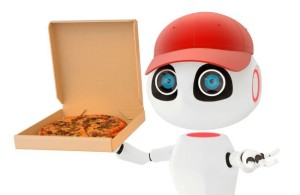And so come Robo-Burger
From 2005 through 2014 I taught a number online courses for the University of Phoenix including MBA Capstone projects, Business Strategy for graduate students and undergraduate Java programming. One of the discussion questions I used during that phase was that of a hypothetical Robo-Burger. The discussion question was generally worded like this(circa 2006):
“We live in a remarkable age in which productivity is increasing at an ever increasing rate, computers are getting ever smaller, faster and cheaper, and automation is the norm. Today robots provide much in the way of manufactured goods. As these trends continue, and advances in artificial intelligence slowly bring more human-like qualities to robotic interactions, it is just a question of time before almost all avocations that are staffed by humans today will be automated.
For the sake of discussion, consider Robo-Burger — a hypothetical franchise in which the entire supply chain (including production of agricultural goods and transportation) is automated. From raw input (cattle, grains, milk, sugars, fats, wood) to refined inputs (beef, buns, pies, frozen fries, wrapping paper) to supplies in the retail store (packaged, shipped and unloaded) to preparation (cooked, assembled, wrapped for the customer) to one-on-one customer interaction, to the financial transaction itself — the entire chain is automated.
Imagine Robo-Burger. Will it happen in your lifetime? Would you eat there? What are the technological barriers? What are the sociological barriers? Which is greater?”
Over that ten year period, I saw students go from mostly skeptical (it could never happen) to mostly accepting the possibility, at least as far as technology is concerned. The sociological impact remained the most difficult to digest. Here we are now, ten years after my first asking that question, and the age of Robo-Burger is upon us.
The reality of Robo-Burger is in part goaded by advancing automation technologies. But growing governmental increases in minimum wage to $15 per hour and beyond in the United States now is also a driving factor. Though Robo-Burger, while a very probable innovation coming soon to a store near you, is not the end of the story, but only the beginning. Robo-Burger, as students I taught grappling with the idea realized, is a metaphor for the Network Age redefinition of the Industrial Age artifact we have come to know as “jobs.”
Try this simple experiment. Open a browser window to search using Google. Type in “jobs lost automation” (no quotes), and wait 1/2 second for the 12+ million page results to be listed, 10 listings per page, ranked. Then click the “News” link at the top. No matter what time or day you search for the next (guessing) 2 years, you will find recent articles bemoaning, celebrating, recognizing or denying the loss of human jobs to automated systems. You will find at least a dozen published in the last 60 days. OR you can just CLICK HERE.
The Robo-Burger transition phase is now upon us. All human jobs that can be automated will be automated. Clearly, if the only change was technological elimination of Industrial Age jobs, the outcome would not be sustainable. It is therefore obvious that other major shifts must also occur.
If not jobs, then what? Whatever shall we do?

Some have argued that new kinds of jobs for humans will emerge, which is probably true. Data Scientist, for example, is a job category that did not exist ten years ago. The Robo-Burger onslaught in every industry will reduce demand for humans in more traditional roles, but increase demand for experts to care for and feed the automating technologies that replace humans.
Imagine a McDonald’s or KFC or Burger King or Taco Bell … pick your poison. Imagine a bevy of highly-skilled systems producing the wares for each order — which were placed through touch-screen or smartphone app. Each order is produced, packaged, bagged, and delivered all without human hands. This automated store, our Robo-Burger, will very likely need two or three humans on the premises at all times. These humans are trained to keep the automated systems happy. So there are the jobs. And sure, paying $15 for those workers is a bargain. Especially when you consider the fact that 20 or more human beings per store per shift are required to keep the same store running smoothly today.
Bear in mind, in the aggregate, advances in technology yield significant increases in productivity. We do more with less. Incremental increases in productivity have been the hallmark of human endeavors for centuries. This is good news. It means less stress on finite resources, lower costs, more stuff. Add to that the exponential increases with Moore’s Law-related technologies, and the idea of effectively free stuff is now reasonable to consider. So Robo-Burger should be a $1 menu dream.
But we are still stymied … even with our Robo-Burger machine repair gigs, we haven’t grown jobs. In fact, we’ve done just the opposite.
So the question remains: whatever shall we do?
I’ll leave that interesting question for another day.
Today, we celebrate the emergence of Robo-Burger. Would you like fries with that?